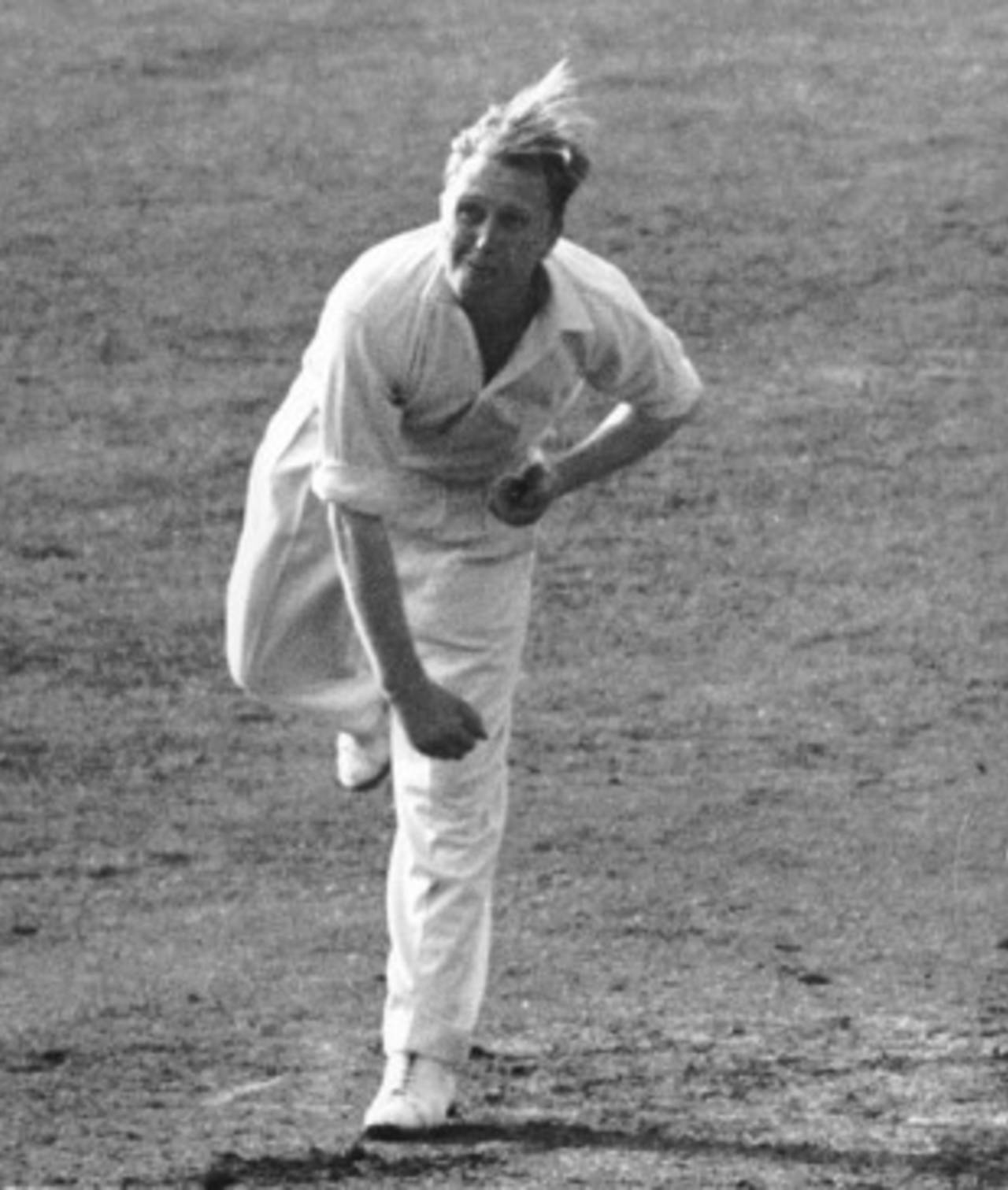The smiling spoilsport
He may be remembered for one delivery, but there was rather more to the Falstaff-like Warwickshire leggie born 98 years ago today
Michael Billington
05-Jun-2010

Eric Hollies: Shane Warne minus the highlights • Getty Images
Eric Hollies has an assured place in cricket history: as the party pooper of all time. And although it's a story every cricket lover knows, it bears retelling. The date is August 14, 1948 and Don Bradman is making his final Test appearance, needing only four runs to achieve an average of 100. As Bradman makes his way to the wicket, The Oval rises. In the middle the England captain, Norman Yardley, raises his cap, calls for three cheers, and then shakes the Don by the hand. The crowd falls silent in expectation. Bradman takes his guard and Hollies bowls him an orthodox legbreak. The next ball, a googly, is pitched slightly further up. It draws Bradman forward, he misses it and looks back to find his stumps shattered. The great man departs: "bowled Hollies 0".
As an eight-year-old living in the heart of Warwickshire, my ear was clamped to the radio, where John Arlott apparently spoke for the nation. "I wonder," said Arlott, "if you see a ball very clearly in your last Test in England, on a ground where you've played some of the biggest cricket of your life, and where the opposing side has just stood round you and given you three cheers, and the crowd has clapped you all the way to the wicket. I wonder if you really see the ball at all." Len Hutton added to the myth when he quoted Bradman saying, "It's not easy to bat with tears in your eyes."
But we in Warwickshire had a different view. We knew that our man Hollies, the most cunning spin bowler in England, was simply too good for Bradman. We also subsequently found out that Hollies, who had bowled Bradman 10 days earlier in a county game where he took eight Australian first-innings wickets for 107, was working to a plan: "I'll bowl the googly second ball," Hollies had told Tom Dollery before leaving for The Oval, "just in case he's expecting it first one." As for the theory that emotion overcame Bradman, Jack Crapp, who was fielding at first slip, seemed to demolish that when he said: "That bugger Bradman never had a tear in his eye his whole life!"
Whatever the truth, Hollies was always my schoolboy hero: not so much because of his deeds for England as for the way he played for Warwickshire. He was the ultimate pro, regularly bowling well over 1000 overs a summer. Long before Shane Warne was born, Hollies showed that a leggie could combine devastating accuracy with guile: astonishing to think that in a career that lasted from 1932 to 1957 he conceded only 2.23 runs an over. But above all there was an innate cheerfulness about Hollies. Again like Warne - though without highlights - he was a stocky, rotund, fair-haired figure, who looked as if bowling was a pleasure and nature's gift, not a punishment. As Neville Cardus once said of Johnny Briggs, the Lancashire bowler: "He had just to show his face and a light passed over the field and with it a companionable warmth."
Nowhere was Hollies' humour more apparent than in his batting. He was one of the game's legendary rabbits, who in his first-class career took more wickets (2323) than he scored runs (1673). I can still hear the ironic roar that greeted him every time he came out to bat. On reaching the crease he would solemnly pat the wicket with the back of his bat, in imitation of a real batsman. On one famous occasion at Worcester, finding all the fielders clustered close for his arrival, he handed his bat to the umpire and crouched down in the leg trap.
Humour was also for Hollies a form of protection. He had a spasmodic career for England, first playing against West Indies on the 1934-35 tour. And after his heroic deeds at The Oval in 1948, he played against the New Zealanders in 1949, and West Indies in 1950. That, and another brilliant Warwickshire season where he took 117 wickets at 18.13, led to his selection for the 1950-51 tour of Australia and New Zealand. But he was constantly passed over for the Tests in favour of the kangaroo-hopping leggie Doug Wright. One baking-hot day in Sydney, ignored by his skipper Freddie Brown, Hollies was fielding down by the Hill when the locals barracked him. "What's the matter - don't they bury their dead in Birmingham?" someone shouted. "No, they stuff 'em and send 'em out to Australia," was Hollies' reply, and from that moment he had the Hill in the palm of his hand.
I like to remember Hollies in his pomp, in the great 1951 Championship-winning Warwickshire side. He took 145 wickets that summer and, with his Brearleyesque captain Dollery, was the team's linchpin. I can still see now the Hollies smile, the deceptively slow amble up to the crease, the ingenious mix of orthodox legbreaks, topspinners and googlies. And I recall one particular, late-July match against Yorkshire where he took nine wickets in all and where the aggregate attendance was an astonishing 43,000. That was the county game at its best; and for me Eric Hollies, affable as Falstaff, yet full of the leggie's cerebral cunning, was the perfect embodiment of the winning spirit of Warwickshire cricket.
Michael Billington is drama critic of the Guardian and a lifelong Warwickshire supporter. This article was first published in Cricinfo Magazine in May 2007